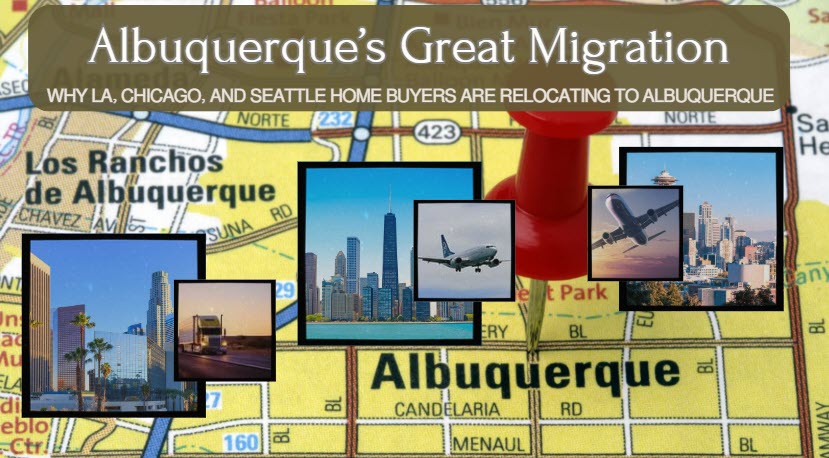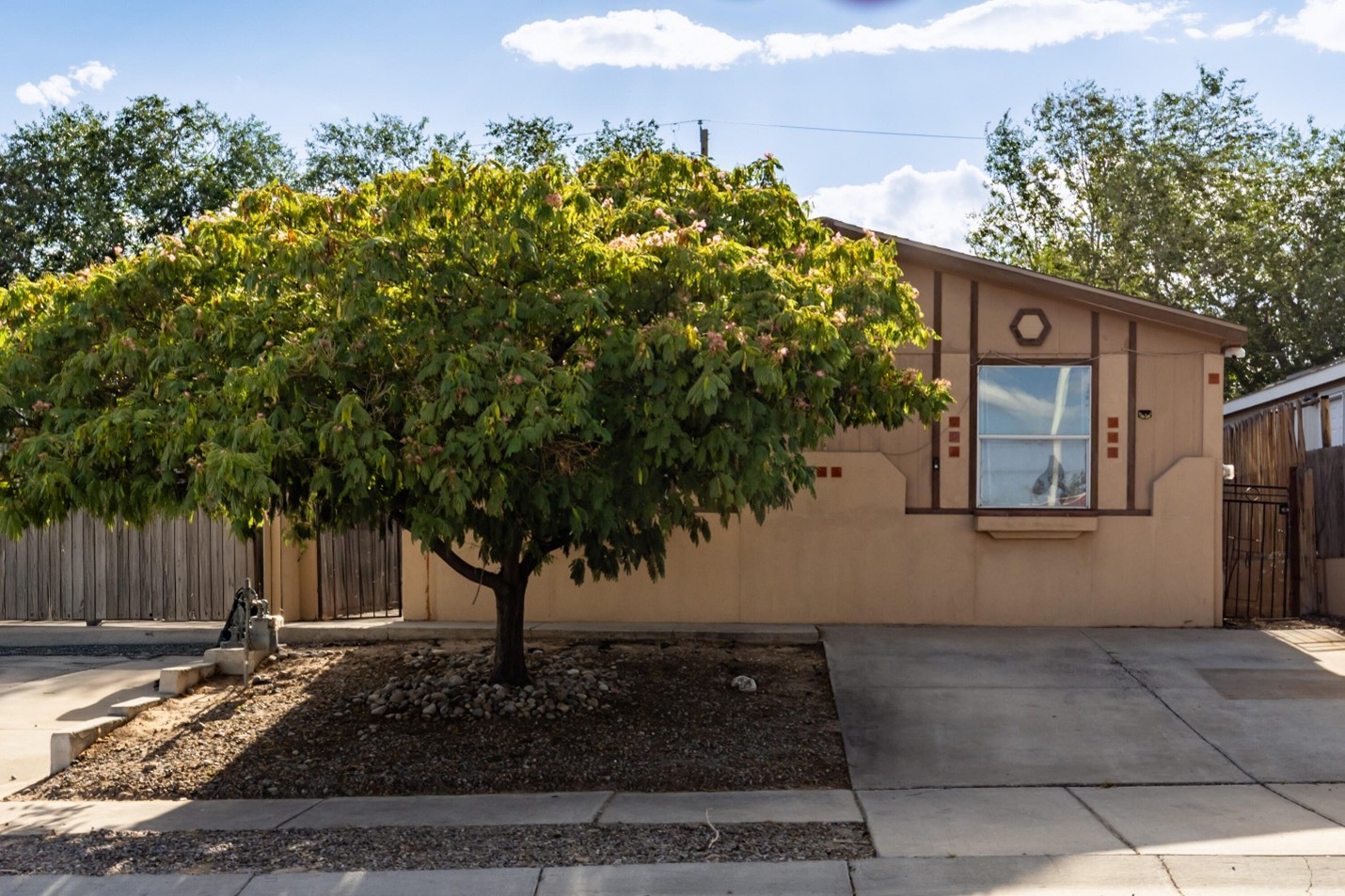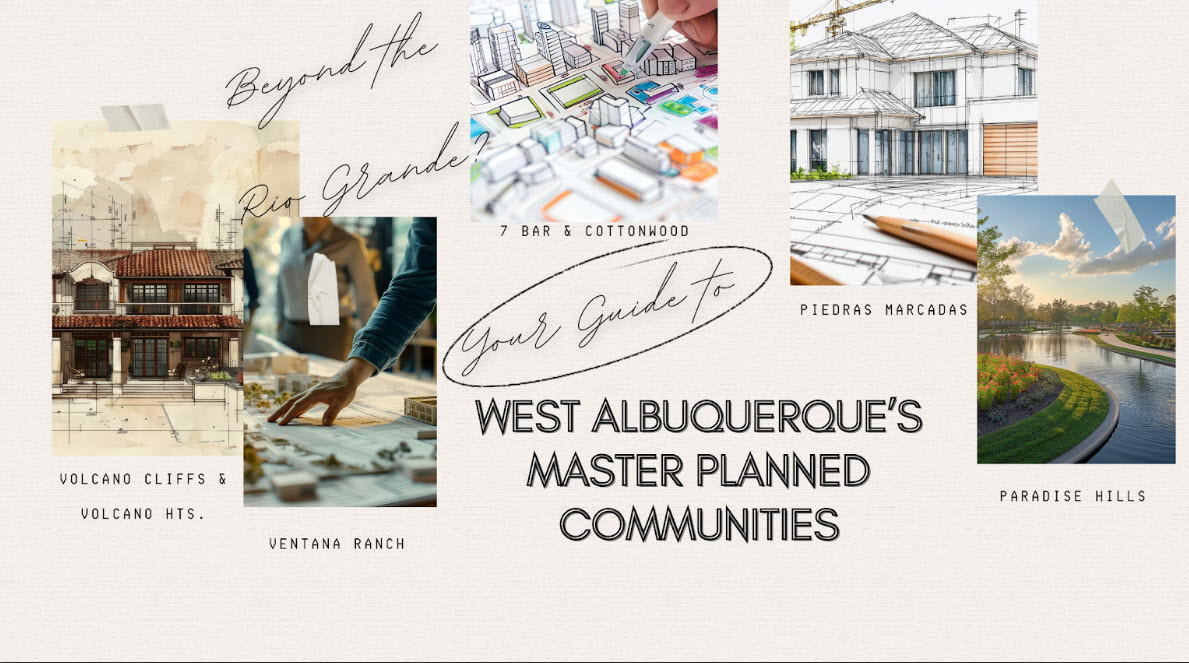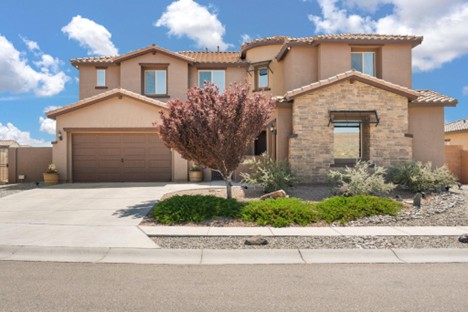Why LA, Chicago, and Seattle Home Buyers Are Relocating to Albuquerque

Albuquerque’s Great Migration! Something remarkable is happening in Albuquerque, New Mexico, Real Estate. Suppose you're reading our article on your laptop in your cramped apartment in Venice Beach, your overpriced condo in Lincoln Park, or your cloudy Seattle neighborhood.
In that case, pay attention. The best-kept secret is out! Did you know that Los Angeles homebuyers searched for Albuquerque Real Estate and Albuquerque relocation information more than any other metro area in America, followed closely by Chicago and Seattle residents?
Frankly, we're not surprised. As longtime Albuquerque residents and real estate professionals, we at the Sandi Pressley Team have been experiencing this migration firsthand. We've been telling people for years about the incredible quality of life here in Albuquerque. Still, the rest of the country is finally catching on to what we've known all along.
First, let's discuss the elephant in the room, or should we say, the money still in your bank account? The numbers don't lie, and your dollar goes much further here than you might imagine. To keep the same standard of living that would require $9,600 in Los Angeles, you would need to make just about $6,846 in Albuquerque. That's not a typo. Albuquerque is 29% cheaper than Los Angeles, which means you can finally afford that dream home with a yard, maybe even a casita for guests.
For our friends coming from Seattle, the savings are even more dramatic. To maintain the same standard of living that would require $11,000 in Seattle, you would need just about $7,248 in Albuquerque. That's 34% cheaper than Seattle! Imagine what you could do with all that extra money – maybe finally take that pottery class you've been putting off or invest in a side business.
Chicago folks aren't left out either. While the Windy City isn't quite as expensive as the coastal markets, the cost of living in Albuquerque averages $1,985, compared to Chicago's $2,250; that difference adds up quickly over time.
Let's paint you a picture of what life actually looks like here, because life here is about more than affordability. Albuquerque is truly a wonderful place to live. So, before you think we're just trying to sell you on cheap living, Albuquerque boasts a lower crime rate, a vibrant and diverse community, beautiful natural wonders, and over 310 days of sunshine per year. Yes, you read that correctly – more than 310 sunny days!
For our Seattle friends who are tired of checking if that's rain or mist hitting their windows, this alone might be worth the move. The outdoor lifestyle here is unmatched. Albuquerque's diversity of elevations ranges from one mile in the cottonwood forest of the Rio Grande Valley to 10,678 feet at Sandia Peak; you can literally ski in the morning and hike in the desert in the afternoon. The city boasts a vast network of paved bike trails throughout, including the gem of the network, the Paseo del Bosque Trail, which runs north and south through the town for approximately 16 miles along the Rio Grande.
Our cultural scene is vibrant and authentic, not the manufactured kind you might find in more touristy places. Maybe you've heard of the world-famous Albuquerque International Balloon Fiesta but aren't aware of all the amazing cultural festivals the city hosts. The city hosts numerous festivals, including a mix of Native American, Hispanic, and Anglo cultures, which creates something truly unique. You won't find this blend anywhere else, and the food–oh, the food! Green chile on everything isn't just a stereotype; it's a way of life, and once you try it, you'll understand why.
The job market is stronger than you think, which addresses one concern we hear from potential relocators about career opportunities. The city boasts a thriving, diverse economy, with job opportunities in various sectors, including technology, healthcare, education, and tourism. For example, Albuquerque's major employers, such as Sandia National Laboratories and the University of New Mexico, ensure a steady stream of job openings. Additionally, the city's startup scene is thriving, providing entrepreneurs and small business owners with numerous opportunities.
For tech workers especially, the combination of lower living costs and competitive salaries creates a quality of life that's hard to beat. Many of our clients from California have found that they can accept a slight salary decrease and still come out significantly ahead financially, while gaining a much better lifestyle.
We have a real estate market that actually makes sense, which is where we get excited as real estate professionals. The median sale price has risen to $ 323,000, with the cost per square foot reaching $200, which sounds like a dream to anyone comparing it to LA or Seattle prices. You can actually afford a home with a yard, maybe even a swimming pool, and you won't need to win the lottery first.
The current inventory sits at 2.4 months of supply, which is historically low and still favors sellers.
However, compared to the highly competitive markets many of our clients are relocating from, they feel like our market lets them take a deep breath of fresh desert air. Active listings increased by 12% in December 2024, as we entered 2025, compared to December 2023, indicating a higher number of options for buyers than in recent years.
Albuquerque is known for its diverse population and inclusive atmosphere, and we'll help you find the community you've been looking for. The city boasts an eclectic mix of communities, neighborhoods, cultures, traditions, and languages, fostering a unique and vibrant social fabric. As long-term residents, we can tell you that many of our relocated clients and residents often highlight the friendly and welcoming nature of the local people. We find a sense of community here that has disappeared from big cities.
Unlike some places where it takes years to break into social circles, Albuquerqueños are genuinely welcoming to newcomers. Maybe you're interested in the arts scene in Old Town, the hiking trails in the Foothills, the connection to nature higher up in the Sandias, or the craft brewery scene (yes, we have an amazing one). We're comfortably saying that there's a community of like-minded people waiting to welcome you.
We're the right team for your Albuquerque adventure because, as the Sandi Pressley Team, we've been calling Albuquerque home for decades. We know this city inside and out – from the best green chile spots to the neighborhoods where you'll find your tribe. We've helped hundreds of families make the transition from high-cost coastal cities to the Land of Enchantment, and we understand the unique challenges and opportunities that come with such a move.
We're not just your typical real estate agents. We're relocation experts who take the time to really listen to what you're looking for, and we'll match you with not just a house, but a lifestyle of your choosing. Whether you're a tech professional who wants a home office with mountain views, a family looking for a safe neighborhood with great schools and outdoor access, or an investor seeking properties with strong rental potential, it would be our pleasure to help you find your perfect fit.
We know which neighborhoods offer the best commute to Sandia Labs, where to find the most authentic local culture, and which areas are seeing the most substantial appreciation. More importantly, we understand what it's like to leave behind everything familiar and start fresh in a new place. We're here to make that transition as smooth and exciting as possible.
Are you ready to join the migration? The great migration to Albuquerque is happening whether you join it or not. Still, we'd love to help you become part of this growing community of people who've discovered that you don't have to sacrifice quality of life for affordability. In fact, here in Albuquerque, you get both.
National data trends indicate that other markets may be stabilizing; however, they are likely to stabilize at price points that remain challenging for many buyers, especially younger buyers. Albuquerque offers a unique blend of affordability, stability, and quality of life that lays the foundation for sustained growth and real estate success.
Suppose you're ready to explore what life could look like with 310+ days of sunshine, genuine community connections, incredible outdoor recreation, and a housing market where your dollars actually stretch. In that case, we're here to help make it happen.
Don't let this opportunity pass you by. The secret is out about Albuquerque, and we'd love to help you discover why so many people are calling the Duke City their new home. Whether you're just starting to think about a move or you're ready to start house hunting tomorrow, we're here to guide you every step of the way.
Ready to make your move to Albuquerque? Contact the Sandi Pressley Team today!
Visit us at: https://www.albuquerquehomesolutions.com/
Call us at: (505) 263-2173
Let's turn your Albuquerque relocation dreams into your new reality.
HOT PROPERTY OF THE WEEK
209 Westcourt Place NW, Albuquerque, NM 87105

Manufactured home in a well-kept community. The home features 3 bedrooms and 2 bathrooms. The home has been freshly painted and has a roof warranty that is transferable. This home will not last long, please bring your buyer today. This home is close to schools, many amenities and easy access to the highway for commuting.
GET YOUR MORNING INSPIRATION WITH THE Sandi Pressley TEAM!















